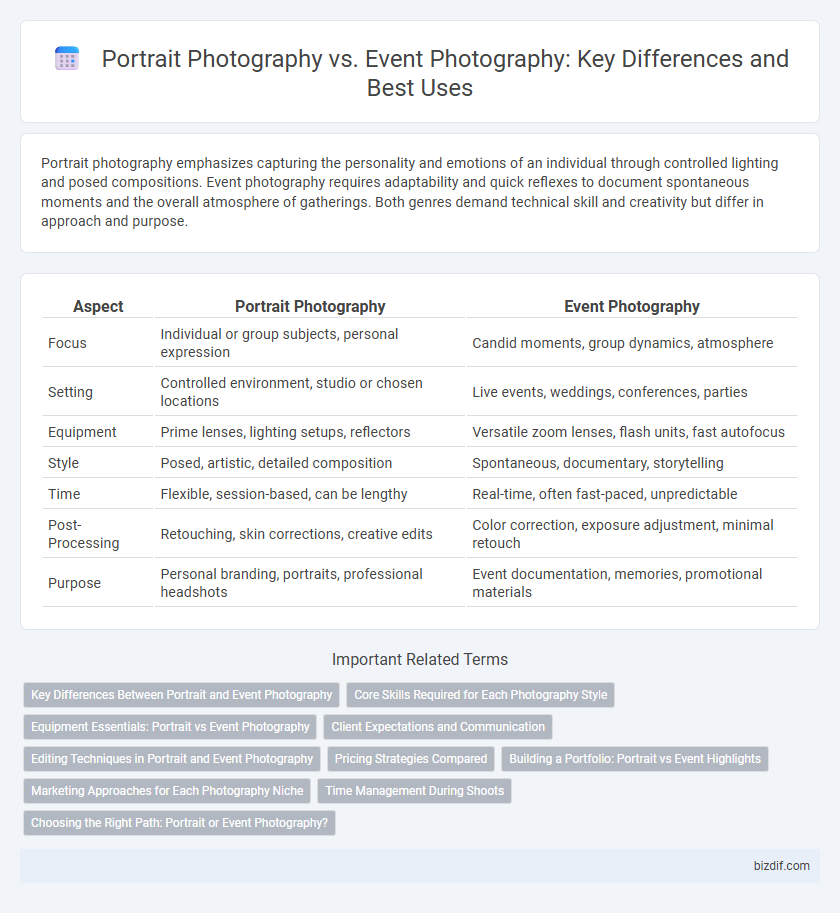Portrait photography emphasizes capturing the personality and emotions of an individual through controlled lighting and posed compositions. Event photography requires adaptability and quick reflexes to document spontaneous moments and the overall atmosphere of gatherings. Both genres demand technical skill and creativity but differ in approach and purpose.
Table of Comparison
| Aspect | Portrait Photography | Event Photography |
|---|---|---|
| Focus | Individual or group subjects, personal expression | Candid moments, group dynamics, atmosphere |
| Setting | Controlled environment, studio or chosen locations | Live events, weddings, conferences, parties |
| Equipment | Prime lenses, lighting setups, reflectors | Versatile zoom lenses, flash units, fast autofocus |
| Style | Posed, artistic, detailed composition | Spontaneous, documentary, storytelling |
| Time | Flexible, session-based, can be lengthy | Real-time, often fast-paced, unpredictable |
| Post-Processing | Retouching, skin corrections, creative edits | Color correction, exposure adjustment, minimal retouch |
| Purpose | Personal branding, portraits, professional headshots | Event documentation, memories, promotional materials |
Key Differences Between Portrait and Event Photography
Portrait photography centers on capturing the personality and mood of a single subject or small group, often in controlled settings with customized lighting and poses to highlight facial expressions and details. Event photography documents live occurrences such as weddings, concerts, or corporate functions, emphasizing candid moments and the overall atmosphere with dynamic, often unpredictable lighting conditions. The primary difference lies in portrait photography's emphasis on staged, intentional compositions versus event photography's focus on spontaneous, narrative-driven imagery.
Core Skills Required for Each Photography Style
Portrait photography demands strong skills in lighting control, posing guidance, and creating a connection with the subject to capture personality and emotion. Event photography requires expertise in candid shooting, quick adaptability to changing environments, and proficiency in capturing key moments under varied lighting conditions. Mastery of technical camera settings and post-processing techniques is crucial for both styles to enhance image quality and storytelling.
Equipment Essentials: Portrait vs Event Photography
Portrait photography demands prime lenses with wide apertures like f/1.4 or f/1.8 to achieve sharp focus and creamy bokeh, along with controlled lighting setups such as softboxes or reflectors to highlight facial features. Event photography requires versatile zoom lenses, often a 24-70mm or 70-200mm, to capture a variety of moments from different distances, paired with fast autofocus systems and portable flash units for dynamic, low-light environments. Studio-grade tripods and tethering tools are crucial for portraits, whereas lightweight, flexible gear enhances mobility during fast-paced events.
Client Expectations and Communication
Portrait photography demands clear communication regarding desired poses, lighting preferences, and personal style to capture the client's unique personality effectively. Event photography requires proactive interaction to understand key moments, schedule flexibility, and crowd dynamics, ensuring comprehensive coverage of the occasion. Both genres necessitate setting realistic expectations about turnaround time, deliverables, and post-processing to foster client satisfaction.
Editing Techniques in Portrait and Event Photography
Portrait photography editing emphasizes skin retouching, color grading to enhance facial tones, and background blurring to focus on the subject. Event photography editing prioritizes color correction for varied lighting conditions, noise reduction for low-light shots, and cropping to capture dynamic moments. Both genres utilize techniques like sharpening and contrast adjustment but differ in their approach to subject emphasis and context preservation.
Pricing Strategies Compared
Portrait photography pricing typically involves fixed packages based on session duration, number of edited images, and print options, reflecting the personalized and controlled environment. Event photography pricing often relies on hourly rates or full-day coverage fees, accounting for the unpredictability and extended time commitment of capturing dynamic moments. Understanding these distinct pricing strategies helps photographers tailor their service offerings and clients forecast their budget effectively.
Building a Portfolio: Portrait vs Event Highlights
Building a portfolio in portrait photography centers on showcasing diverse expressions, lighting techniques, and individual character through carefully composed headshots and environmental portraits. Event photography portfolios emphasize capturing dynamic moments, crowd interactions, and atmosphere, highlighting the photographer's ability to adapt to varying conditions and tell a visual story. Including a balanced mix of both styles demonstrates versatility, attracting clients seeking personal or large-scale event coverage.
Marketing Approaches for Each Photography Niche
Portrait photography marketing emphasizes creating emotional connections through personalized branding, targeted social media ads, and collaborations with influencers to attract clients seeking individual or family sessions. Event photography marketing targets organizations and event planners by showcasing portfolio highlights, leveraging SEO with event-specific keywords, and offering package deals for weddings, corporate gatherings, and parties. Both niches benefit from client testimonials and visual storytelling to build trust and demonstrate expertise.
Time Management During Shoots
Portrait photography requires meticulous time management to ensure optimal lighting, composition, and subject comfort within a limited session. Event photography demands rapid adaptability and efficient time allocation to capture spontaneous moments across dynamic settings. Balancing precise shot planning in portraits against the fast-paced nature of events enhances overall shoot productivity and quality.
Choosing the Right Path: Portrait or Event Photography?
Choosing between portrait and event photography depends on your passion for capturing individual expressions versus dynamic group interactions. Portrait photography demands mastery in lighting, posing, and creating emotional connections to produce timeless images of a subject's personality. Event photography requires quick adaptability, anticipation of key moments, and skill in documenting diverse scenes to tell a comprehensive visual story of an occasion.
Portrait Photography vs Event Photography Infographic

 bizdif.com
bizdif.com